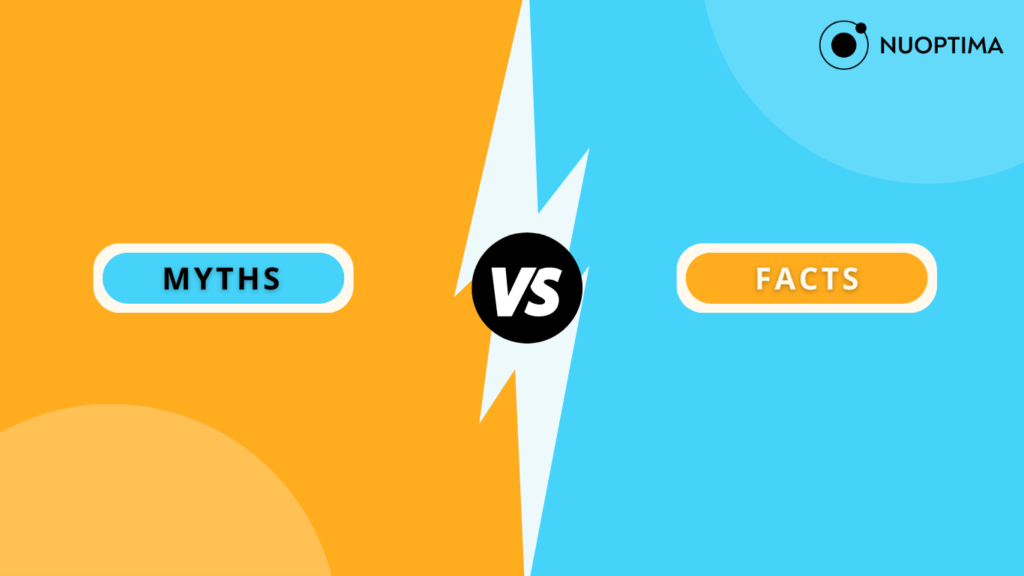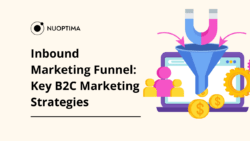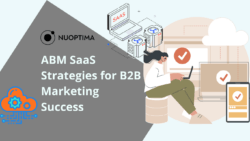Key Points
- Category design is a business strategy that involves businesses planning, creating, and dominating brand-new product and service categories. It is essentially proactively designing a fresh market.
- Famous examples of successful category design include Tesla, Apple, and Red Bull.
- Some common misconceptions about category design include it being too expensive, being only relevant for trendy, consumer-facing products, and being less important than branding.
- To win your category and become a category leader, you should determine or redefine it, use competition to your advantage, build brand awareness, use customer insight and feedback to improve upon it, and welcome competitors when they finally enter your category while continuously innovating to remain at the top.
- In addition to reading this article, it is a fantastic idea to enlist the help of a professional full-stack growth agency, such as NUOPTIMA, an expert organization in transforming startups into category leaders.
Introduction
The phrase ‘category leader’ often seems overwhelming and out of reach to many entrepreneurs and business leaders because they tend to associate category design with big tech and assume that you need millions of dollars to create a category. But the truth is, anyone can develop one and achieve category leadership.
Brands like Airbnb, Netflix, and HubSpot are a testament to the fact that:
- You don’t need loads of money to design a new category;
- People are open to change;
- A new business can reinvent the wheel.
In this article, we will guide you through the process of designing a category and detail what it takes to become and maintain your position as a category leader.
Why not begin your journey by watching the video below and learning directly from our CEO how to dominate your niche and become a category leader? In this video, Alexej shares advantages, tips, and success stories to help inspire you in the quest to lead your niche.
How to Design Your Category
What Is Category Design?

Category design is a business strategy that involves planning, creating, and dominating new product and service categories. It involves proactively designing the new market to ensure a step up on any competition that enters the same space. Unlike other strategies that focus on business models, products, and taking market share, category design casts a broader net by designing the new market to ensure the company dominates and beats the competition.
The term ‘category design’ was first coined in the 2016 book ‘Play Bigger’[1], which explains why designing a category is a worthwhile strategy. The book talks about category creation being connected with cognitive biases. Indeed, our brains categorize things organically. For instance, if someone were to think of buying a new bike, they would consider various bike brands and specifications. Naturally, the brand that sticks out in that category will spring to mind first. Therefore, category creation is forming a category in people’s minds and ensuring your product has a bias in that category.
Statistics collected on companies that have created categories support and validate the concept:
- As mentioned in ‘Play Bigger’, category leaders typically receive 76% of a category’s economics[1].
- According to a 2013 study by Linda Deeken and Eddie Yoon, only 13 of the Fortune 100 companies were category creators. Despite being a minority, these businesses were responsible for over 50% of the Fortune 100’s gradual growth and almost 75% of its growth in market capitalization[2].
Let’s now consider some of the primary principles of category design:
- It is a company-wide strategy that changes its mindset about what it wants to accomplish and how it intends to do so.
- Category design is about working to solve a new problem (or resolving an established problem in a unique way).
- Category leaders and designers do not compete with competitors over specific features or pricing. Instead, they do so by presenting a fresh approach that competitors simply cannot relate to.
- Category design is a continual process that never really has a finish line. On the one hand, the process can be quick, such as when introducing a new category in a new market, like CBD or functional mushrooms. However, more often than not, it takes years before the work pays off because altering the way buyers think does not happen overnight. An example of this is the vacuum cleaner brand Dyson. Although it is a clear innovator and is currently the leading brand, people have yet to call a vacuum cleaner a Dyson universally.
Did you know? According to the Harvard Business Review article ‘How Unicorns Grow,’ ‘category kings’ (companies that dominate a category) that choose to go public when they are 6 to 10 years old make the most value (among all venture capital-funded tech businesses): the 6-10 law[3]. It claimed that organizations that go public before six years old commonly lose value, while those that take more than 10 years do not create much value for shareholders either. It is argued that categories take roughly six years to develop, and the majority of their growth occurs within the six to 10-year parameter.
Famous Examples of Category Design
Below, we offer some further examples of companies that have successfully designed new categories.
Salesforce
Salesforce launched in 1999 and is one of the best illustrations of category design in cloud-based software. When the company started, organizations had to purchase expensive software through what is known as the on-premise model, meaning they had to buy a copy of the software (or a license) to use it. Consequently, database-driven software, such as customer relationship management (CRM), was not an option for small, modest companies.
Salesforce set out to address the issue of limited access to CRM software by making it available to everyone at any time of the day via a global cloud computing infrastructure. They achieved this by introducing online CRM software that could be accessed through the internet (the cloud). At the time, Salesforce was the only software as a service (SaaS) provider, and they became the driving force behind the cloud computing revolution, establishing themselves as true category designers.
Tesla
Founded in 2003, Tesla has become ‘the name’ associated with electric cars. Why? Tesla did not invent the electric car, but it did reinvent the electric vehicle category. Traditionally, electric automobiles were intended for people whose primary concern was fuel savings. But Tesla took a different approach. It decided that rather than creating a reasonably affordable automobile that could be mass-produced, it would establish itself as a category leader by developing an enthralling vehicle that would create demand.
Despite the Chinese car company BYD (Build Your Dreams) officially outselling Tesla in electric cars for two consecutive years, Tesla remains the dominant association with electric vehicles[4].
Apple
While Apple has invented certain technologies, its ability to develop and reinvent an existing product has awarded it the title of category leader. Apple has a unique ability of developing scalable products and popularizing them. In fact, Apple was the first successful personal computer business and made the graphical user interface popular.
Part of the reason for Apple’s domination is its ability to create an enjoyable, rich, and simple user experience. It did not invent the smartphone, the laptop, or MP3. Still, it used its strategic vision, which focused on performance and design, to drive its success, revolutionize the tech industry, and establish itself as a household name.
Red Bull
Red Bull is the undisputed king of energy drinks. But what has made them category designers? Put simply, the answer is marketing. Red Bull puts its product secondary to the activities that its demographic enjoys. Its target audience is young, active consumers, and Red Bull knows people within this age range are particularly clued up regarding adverts. So, rather than trying to market the drink to them, which would turn them off, it focuses on the activities that its demographic enjoys.
For example, the brand sponsors numerous extreme sports, which are known for their high-adrenaline nature. By associating themselves with these events, Red Bull has created a strong link between its brand and the exhilaration of extreme sports. This understanding of its audience has helped Red Bull become a category leader by prioritizing its content and value to the audience rather than solely focusing on its product.
Wrigleys
This is perhaps one of the oldest examples of category design. William Wrigley Jr. started out selling soap. As a promotional offer, he would include baking powder in each order. After some time, he discovered that baking powder proved more popular than the soap. Therefore, Wrigley decided to focus his efforts on selling baking powder and instead offered his customers two chewing gum packs with every purchase as another promotional giveaway.
Same as before, the promotional product was more popular than the original item he was selling. He was not afraid of change and focused on whatever the consumer was interested in, so he put all his efforts into chewing gum.
He realized that chewing gum was an impulse buy, so he created display cases and instructed shops to leave them near the tills. After a financial panic in 1907, advertising rates decreased, and Wrigley decided to jump at the opportunity and increasingly expand his advertisement reach. He eventually sold the bestselling chewing gum globally. Wrigley’s ability to listen to and understand his market, coupled with his advertising decision-making, earned his company the title of a category leader of chewing gum to this day.
Myths About Category Design
Let’s look into busting some myths surrounding the topic of category design and leadership.

Myth #1: Category Design Is Too Expensive
Contrary to popular belief, category design does not need to be costly. Although it might require an initial investment in research, marketing, and product development, that doesn’t necessarily mean you need to spend millions of dollars to develop a category. Businesses of all sizes can creatively utilize their existing resources to create or redefine a category and become a category leader.
Dollar Shave Club is an excellent example of this. Despite starting with a modest budget of $4500[5], this subscription startup was able to disrupt and revolutionize the traditional razor and grooming industry by offering high-quality razors at a fraction of the cost of leading brands. Entering the market as one of the first personal care subscription services, their direct-to-consumer (D2C) business model eliminated the middleman and introduced convenience and affordability to their customers, leading them to overtake the razor market.
In addition, by leveraging digital marketing strategies and a strong brand identity, Dollar Shave Club scaled rapidly without incurring high costs and captured a significant market share before ultimately being acquired by Unilever for one billion dollars in 2016[6].
Myth #2: Category Design Is Only Relevant for Trendy, Consumer-Facing Products
Category design is often misunderstood as something that only applies to flashy consumer products or trendy tech gadgets. However, it can be applied to a variety of industries and product types. Whether you’re selling software solutions to businesses or specialized medical equipment to healthcare providers, category design can help differentiate your offering, attract loyal customers, and drive sustainable growth.
Red Hat is a notable example of a category leader and designer in the software industry. By promoting the adoption of open-source software in enterprise environments, Red Hat created a new category within the industry. They positioned themselves as the go-to provider for enterprise-grade open-source software, offering support, training, and consulting services to businesses worldwide.
Myth #3: It Is More Important to Focus on Branding Rather Than Category Design
Although having a strong brand identity is undoubtedly important, it should not be seen as a replacement for category design. Brands are part of a larger category, and defining and shaping a category can significantly improve a brand’s impact and relevance in the market. By establishing a category that resonates with your target audience and addresses their specific pain points, you can take your brand to new heights of success.
Airbnb, a category leader in the travel industry, is a company that illustrates the importance of creating a category rather than solely relying on branding. Airbnb revolutionized the travel experience by introducing the concept of home-sharing, where individuals can rent out their homes or spare rooms to travelers. Rather than focusing solely on branding, they created and popularized the category of peer-to-peer lodging, emphasizing affordability, flexibility, and the opportunity to immerse oneself in the culture of a destination. This helped it differentiate itself from traditional hotel chains and become a disruptor in the industry.
The Category Design Process

Now that we have delved into what category design is and some famous examples, let’s go through an overview of how category design is executed step-by-step.
- Define a category problem: This first step involves determining the core problem you want to solve (as well as for who). This is the main base for the rest of the process. A perfect example is Apple. The iPad was introduced to act as an intermediary between a smartphone and a laptop. The public didn’t know what they were missing, but as soon as Apple created the category, the market followed suit, and Apple was seen as the company that solved this fresh need in the market.
- Form a point of view and decide the category you are creating: This point of view presents the story of why your category is needed and what users will gain from it. Then, you have to determine what category you are making. Can you work out a way of naming it to convey to people that it is not only superior but also different? Because the category has been nonexistent up until now, it requires a category leader with a clear vision and belief in what it could be worth in the future.
- Alter your product roadmap and messages to the market: It is imperative that your product roadmap backs up your category vision. Plus, whatever content you create, such as on your website or in sales decks, must align with your point of view. You must be able to address the category size you aim for. Picking a size too small significantly limits the business. But, making promises you will not be able to meet can mean a competitor overtaking you. It is, therefore, crucial that you are confident you can address the size of the category.
- Proclaim the category: This is the time to share your aims and visions for the category worldwide. This can be accomplished through any means that the world will hear about, such as podcasts, adverts, blogs, and more.
- Utilize lightning strike moments: Lightning strikes are your chance to shock and entice your customers by creating a memorable experience that differentiates your value. Examples of lightning strikes include marketing stunts, product launches, industry conferences, and PR campaigns.
How to Win Your Category and Achieve Category Leadership
Let’s explore some reasons why it’s important to be a category leader now more than ever before and guide you through a step-by-step process on how to establish yourself as a category leader.

Reasons to Become a Category Leader
- Starting a company today is much easier than it was 20 years ago. However, the downside is that the market is now saturated with thousands of similar companies trying to achieve the same goal, making it difficult to stand out. To overcome this challenge, you need to establish yourself as a category leader or ‘king’ in a specific sphere. By doing so, people will consider you as the point of authority and trust you over others.
- Another reason for a company with a digital product or service to become a category leader is that any digital market is essentially a ‘winner takes all’ situation. For instance, the most recent statistics show that Uber is the category leader in transport, as it takes up 25% of the global ride-hailing market share[7].
- Category leaders also tend to draw the best people. They do this by creating an atmosphere of growth, collaboration, and recognition. They also offer compelling visions, opportunities for impactful work, and the chance to be a part of groundbreaking innovation. These factors attract talented individuals who are driven to make a significant impact in their field.
- By establishing a new category, you have the advantage of creating innovative communication strategies. Your focus goes beyond just selling a product; you get the opportunity to educate the market and create a compelling story that connects with your audience. This unique communication style helps you establish considered leadership and solidifies your brand as the ultimate authority in this new space.
- When you take risks and explore opportunities that others have not yet explored, your company becomes a leader in its field! As the pioneer, you set the standards and determine the story of success in this new area. Having this position means that you have the power to steer the market trends and shape how your customers view your product or service, giving you a significant advantage over competitors who arrive later.
- ‘Category kings’ have the unique advantage of setting the prices for their products or services instead of letting the market and competitors determine them. They introduce innovative products that are valued highly by consumers, who are willing to pay more. This is known as ‘premium profitability.’
- Many companies do not strive to be category leaders because they are scared of losing the position they have gained up to this point. These companies are hesitant to go against the grain for fear of failure. Often, these businesses are previous category leaders that initially pioneered the landscape but have stagnated and defended their category despite it being slow-moving. But, the reality is that they should consider the exponential value that could be created by being innovative and pursuing category design and leadership.
- Following on from the previous point, many companies believe that connecting with an existing category is beneficial. They think that by making a new version of a product that is better, cheaper, stronger, and faster, they will receive guaranteed results. This is not always the case. Plus, this method generally has a limited shelf-life. By adjusting your strategy to consider a different category rather than a superior product, there is potential for massive value, long-term sustainability, and the benefit of being a category king.
Example of an Old Category King: Xerox
In the 20th century, Xerox was one of the most innovative businesses in operation, and its machines could be found in virtually every office worldwide. Unfortunately, times have changed, and while Xerox was a category leader, it no longer dominates any relevant category. To clarify, it is not that Xerox has weakened as a brand. Rather, it is the category it was the leader of that is becoming redundant.
Considering our modern digital and often paperless culture, Xerox no longer holds a place. The company is still holding on to what it once had instead of trying to create or invent something game-changing. Therefore, to ensure that you maintain a position as a category leader, you cannot be afraid of change and must be open to creating new, innovative solutions.
Did you know? When it comes to category leadership, far more important than a large budget is the ability to find an opportunity that solves a problem people didn’t know existed or reimagine an established problem and form the foundation for a very different solution.
How to Attain Category Leadership
In order to win the category and become a category leader, you must employ an active marketing strategy to ensure that the market understands and believes in your point of view. Here are several critical steps you should follow to become a category leader:
1. Determine or Redefine Your Category

The first step towards category leadership is determining your category. This involves clearly communicating what you do and the unique problem that only your product, service, or tech can solve, with an emphasis on conveying what differentiates you from existing solutions. However, if you cannot create a new category, you can still be innovative by redefining an existing one. This means taking a well-known problem and using it as the foundation for a unique solution.
At this beginning stage, your priority should be to articulately convey the importance and potential profitability of solving this problem using a handful of descriptive and transparent words. There also needs to be evidence of your prospective category’s viability. This can be established by the presence of experts, customer champions, or competitors (direct or indirect) operating within your chosen niche market. However, to establish yourself as a category leader, it’s essential to differentiate yourself from competitors by either redefining or creating a new category.
2. Use Competition to Your Advantage

While you might not have any direct competition as a category creator, you can still benefit from indirect competitors who target the same audience as you by gathering competitive intelligence. You can obtain this key data by:
- Analyzing your competitors’ websites for product updates, pricing changes, new features, and messaging strategies;
- Studying industry reports and studies to gain valuable information about your competitors’ market share, growth trends, and positioning strategies;
- Reading through online reviews and customer feedback to understand your competitors’ strengths, weaknesses, and areas for improvement;
- Monitoring their social media to track their engagement and content strategy;
- Reading through job postings to get an idea of the areas of their business they are trying to grow.
Having this information can help you gain a deeper understanding of your target market and lead you to fine-tune your offerings to better meet their needs. At the end of your competitor analysis, you should have a more refined and research-backed strategy for your own business.
3. Build Your Brand Awareness

Building awareness is paramount when creating a new category or disrupting an existing one, especially if you want to position yourself as the category leader, and one way you can do this is through content marketing. You want to ensure that your brand message is embedded in every aspect of your content, including product description, features, images, taglines, and value proposition. This way, potential customers who come across your content know exactly who you are and what you offer. For professional help for software companies, check out our SaaS content marketing agency services.
Beyond messaging, you also need to increase awareness of your brand by attending industry conferences, meet-ups, and investor events to spread the word and establish yourself as a credible business in your industry. This personalized touch also distinguishes you from faceless corporations and resonates more profoundly with your audience.
4. Utilize Customer Insight and Feedback

It doesn’t necessarily matter if you create or redefine a category. What’s most important is leading it, and to do this, you need to know what your customers are thinking and feeling at all times in order to satisfy them.
You can start by mapping out your customer journey to understand their experience with your company and product at every stage. To do this, you’ll need to:
- Define your customer personas;
- Identify all the touchpoints where a customer interacts with your business, both online and offline;
- Break down the customer journey into stages that align with your business objectives and customer interactions;
- Map customer actions and emotions for each stage of the customer journey;
- Highlight pain points or obstacles that customers may encounter.
Once you have this, you can then adjust your sales, marketing, and customer service strategies to meet customer needs at each stage of their journey. If you own a B2B SaaS business, check out our ultimate guide to the B2B SaaS customer journey.
Customer feedback is also important. You need to know what customers are saying about your products. How is your product meeting their needs? Where is it lacking? You can keep your finger on the pulse of your customers’ feedback by utilizing online reviews, surveys, and feedback forms, as well as obtaining case studies, reference accounts, and press releases.
You can use positive feedback to validate your category by featuring favorable quotes and reviews in your marketing channels. You can also use constructive criticism to improve your offerings.
5. Remain at the Top of Your Category
With the right product, marketing strategies, and approach, you can effectively carry out category design and establish yourself as a category leader. Eventually, when you attain success, the larger companies will stop criticizing and discrediting you and start imitating what you have accomplished. You should always welcome them into your new category because, in the end, it is a clear validation of your vision. Always keep in mind that when bigger businesses embrace your category and have to adjust to the disruption you’ve created, it just means that you have arrived and are now a real category king!
When this happens, though, how can you make sure you remain at the top?
Establishing a culture of hard work, innovation, and continuous improvement has proven effective in ensuring success. Do not hesitate to enhance your current offerings or introduce new ones. However, the most crucial aspect is to prioritize your customers’ needs and strive to consistently deliver excellence that they can always count on. To learn more about this, here is a YouTube video from our CEO Alexej Pikovsky featuring a step-by-step guide to winning your category:
Invest in the Services of Full-Stack Growth Agency NUOPTIMA
When it comes to scaling a company, there are numerous routes that entrepreneurs can go down to achieve this task. For instance, they might consider raising capital for their brand. If you own a SaaS company, enjoy our article on SaaS requirements and benchmark of raising capital to see if this is an appealing option for you. However, one surefire way to scale your brand is to enlist in the services of a professional growth agency, such as NUOPTIMA.
Many agencies specialize in SEO, PPC, and LinkedIn, but we are different. We are the growth agency that prioritizes helping startups scale. Our branding, case studies, and content on YouTube and Spotify all reflect this. We have helped countless brands in numerous sectors, including SaaS, fintech, cryptocurrency companies, D2C, and B2B businesses. A good example of this is how we helped Zelt, an HR SaaS, achieve 300% traffic growth in just one month.
We also focus on helping build category-leading B2B SaaS businesses. A fantastic example of how we transformed a company into a category leader is Alphagreen.io. With the assistance of NUOPTIMA, it has been announced as the largest CBD marketplace in Europe[8]. Not only this, but Alphagreen was nominated for the ‘Best Scale Up’ award at the 37th Marketing Society Awards. Watch the following interview to learn more about how Alphagreen and NUOPTIMA built Europe’s largest CBD marketplace in six months:
Striving for category leadership alone is no easy feat and requires constant work, diligence, and focus. For this reason, investing in a company that specializes in growing brands is an excellent idea, as it allows you to focus on what you should be doing: running your company. To learn how we can grow your startup into a category leader, book a free discovery call with our expert team at NUOPTIMA today.
Conclusion: Striving for Category Leadership
Navigating an ever-changing business landscape can be challenging, especially when it comes to achieving category leadership. However, this article has shown that category design and leadership are not only possible but are also accessible to small and big businesses alike.
Despite various myths surrounding the concept, category design remains a powerful strategy that gives organizations the opportunity to shape and dominate new markets. By embracing innovation while remaining customer-focused, companies can rise to the top of their respective categories and establish themselves as true category leaders.
FAQ
A category leader takes the lead in a niche by innovating new products or services, understanding customer needs, and influencing market trends. They also stay ahead of their competition, shape buyer perceptions, and consistently deliver value, establishing their product or service as the industry benchmark.
To create a category, a business must first identify a specific market segment that has unique characteristics and needs. This involves introducing new and innovative products, services, or solutions that can challenge industry norms and address unfulfilled customer demands. By establishing a new niche in the market, businesses can differentiate themselves from competitors and achieve category leadership.
There are different ways to become a market leader. You could achieve this by offering the best price and product quality or excelling in your marketing compared to competitors. However, a powerful approach involves innovatively creating a new category, becoming a category designer, and leading the industry by reshaping market dynamics.
References
- https://www.amazon.co.uk/Play-Bigger-Innovators-Categories-Dominate/dp/0349411360[1]
- https://hbr.org/2013/03/why-it-pays-to-be-a-category-creator[2]
- https://hbr.org/2016/01/how-unicorns-grow[3]
- https://www.theguardian.com/environment/2024/jan/02/chinas-byd-overtakes-tesla-as-top-selling-electric-car-seller[4]
- https://www.complex.com/pop-culture/a/christopher-spata/dollar-shave-club-viral-value[5]
- https://www.nytimes.com/2016/07/20/business/dealbook/unilever-dollar-shave-club.html[6]
- https://www.statista.com/statistics/1156066/leading-ride-hailing-operators-worldwide-by-market-share/[7]
- https://www.businessleader.co.uk/europes-biggest-cbd-marketplace-alphagreen-set-to-raise-2m-funding/[8]



